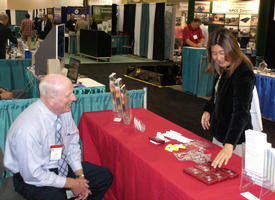 Corps discusses FUDS and public involvement at conference
Corps discusses FUDS and public involvement at conference


Bill Veith, U.S. Army Engineering and Support Center, Huntsville, discusses the U.S. Army Corps of Engineers' Military Munitions Support Services with Helene Y. Takemoto, USACE Honolulu District, at the Joint Services Environmental Management conference. (Photo by Chris Gardner)
Jun. 26, 2007
By Chris Gardner
U.S. Army Engineering and Support Center, Huntsville
The U.S. Army Corps of Engineers made a strong presence representing its Formerly Used Defense Sites (FUDS) mission at the 2007 Joint Services Environmental Management conference in Columbus, Ohio.
Corps representatives discussed lessons learned from trials and tribulations at various projects and how it has dealt with the important issue of public involvement in these projects.
FUDS features ranged from Alaska District's work on a barren and frozen island to Albuquerque District's work in the desert regions of New Mexico.
Mollie TeVrucht, a project manager from Alaska District, discussed work she is leading that involves removing decades old hazardous waste from Distant Early Warning stations in the Aleutian Island of Cape Sarichef in Alaska. The project was complicated by an extremely harsh climate as well as the presence of nearby significant archeological sites.
"Preservation of cultural resources is very important, and I thought our project offered useful lessons learned about conducting a large-scale removal action with nearby archaeological sites," TeVrucht said.
The project site was surrounded by remains from the native Aleuts who were essentially wiped out by foreign hunters and traders who came to the continent in the 1700s.
That property is one of more than 9,900 sites that have been identified for possible inclusion in the Corps' FUDS program.
TeVrucht noted how communicating with all the people involved helped make the project a success.
"I hope the audience saw how beneficial it is to engage in early planning and comprehensive coordination with all stakeholders, landowners and regulators," TeVrucht said.
The theme of communications and FUDS was conveyed throughout the conference with representatives from USACE Headquarters also stressing the importance of public involvement in the FUDS program.
"With the FUDS program, public involvement is crucial," said Candy Walters, public affairs specialist from USACE Headquarters. "At JSEM, we have the opportunity to interact with our sister services and other agencies and companies that are doing the same type of public involvement work we are, to share successes, challenges and opportunities to share tools and ideas."
As part of that communication effort, the Corps also had a display set up to inform attendees about its Military Munitions Support Services (M²S²), which goes hand in hand with the FUDS program.
"It's important that other Department of Defense environmental offices know about the Corps' capabilities regarding the M²S² product line," said Patti Berry, acting special assistant for M²S² at USACE Headquarters.
M²S² covers a wide range of Corps capabilities dealing with FUDS and overall munitions cleanup.
The U.S. Army Engineering Research and Development Center and the USACE Environmental Community of Practice were also represented at the conference getting the word out about their respective missions.
The next JSEM conference is scheduled for May 2008 in Denver.
Added on 06/26/2007 12:10 PM
Updated on 09/27/2007 11:05 AM